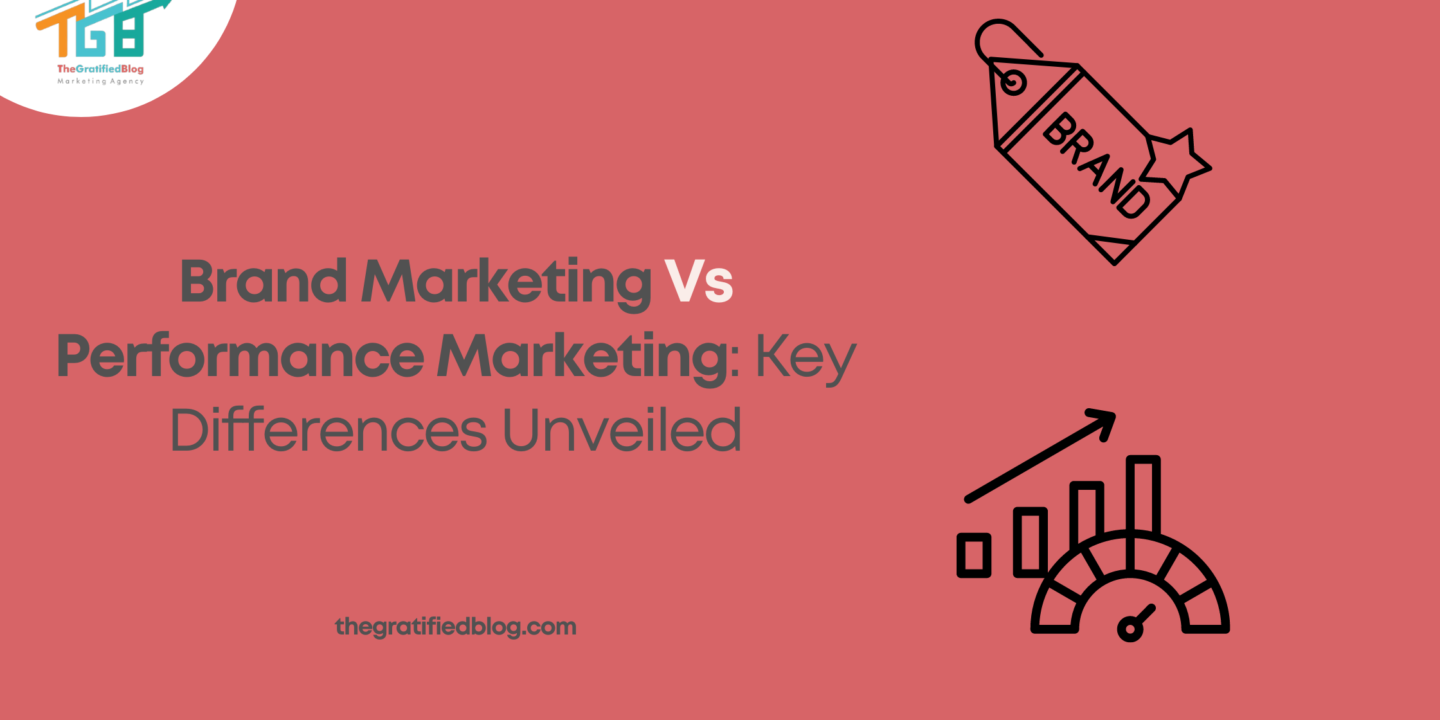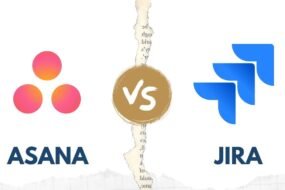
In the dynamic landscape of digital marketing, two powerhouse strategies stand at the forefront: brand marketing and performance marketing. The clash between brand marketing vs performance marketing has sparked debates and discussions among marketers worldwide, each advocating for its unique strengths and advantages.
Understanding the nuances and distinctions between these two approaches is crucial for crafting a comprehensive and effective marketing strategy that aligns with business goals and audience expectations.
Let’s delve into the intricacies of brand marketing vs performance marketing to unravel their essence, dissect their methodologies, and explore how they merge to drive marketing success in today’s competitive landscape.
So, let’s get started:
What Is Brand Marketing?

Brand marketing is a strategic approach focused on creating and enhancing a brand’s identity, perception, and equity in consumers’ minds. It goes beyond promoting products or services but aims to build a strong emotional connection and loyalty with the target audience.
Why Is Brand Marketing So Effective?
Here are five reasons why brand marketing is so effective:
- Building trust and credibility: Brand marketing helps build trust and credibility among consumers through consistently delivering promises, maintaining quality standards, and the embodied values that resonate with the target audience. Brands that are trusted are more inclined to attract and retain loyal customers.
- Creating emotional connections: Effective brand marketing leverages emotions to create memorable experiences and connections with consumers. By tapping into emotions like joy, nostalgia, or inspiration, brands can forge deeper relationships and elicit positive associations with their products or services.
- Nurturing brand loyalty: A robust brand identity and narrative foster brand loyalty among consumers. When customers feel a strong emotional attachment to a brand, they are likelier to opt for it over competitors, even in situations with comparable offerings or pricing.
- Differentiation and competitive advantage: In crowded markets, brand Marketing aids brands in distinguishing themselves from competitors by highlighting unique value propositions, brand values, and positioning. This differentiation leads to a competitive advantage and helps brands stand out in the minds of consumers.
- Long-Term Value and sustainability: Brand marketing focuses on long-term value creation rather than short-term gains. Building a solid brand identity and equity over time ensures sustainability and resilience against market fluctuations or competitive pressures.
Now, let’s delve into the concept of performance marketing.
What Is Performance Marketing?

Performance marketing is a strategy centered around data analysis that aims to drive measurable results and achieve specific objectives, such as generating leads, conversions, or sales.
Unlike traditional marketing, which may prioritise brand awareness or general messaging, performance marketing is highly targeted and relies on metrics and analytics to optimise campaigns and maximise ROI.
Why Is Performance Marketing So Effective?
Here are five reasons why performance marketing is so effective:
- Measurable ROI: Performance marketing emphasises quantifiable results and ROI, allowing marketers to track and analyse key performance indicators (KPIs) such as click-through rates, conversion rates, cost per acquisition (CPA), and return on ad spend (ROAS). This data-driven approach enables marketers to optimise campaigns in real-time and allocate budget to the most effective channels and strategies.
- Targeted audience reach: Performance marketing allows precise targeting based on demographics, interests, behaviours, and intent signals. Marketers can improve campaign effectiveness and drive higher engagement and conversions through targeted audience outreach with relevant messaging at the right time.
- Flexible and scalable campaigns: Performance marketing campaigns are often agile, allowing marketers to test, iterate, and scale campaigns quickly based on performance data. This flexibility enables optimisation strategies such as A/B testing, ad creative variations, and audience segmentation to enhance campaign performance over time.
- Cost efficiency: Performance marketing is cost-efficient because it focuses on paying for desired actions or outcomes, such as clicks, leads, or conversions. Marketers can optimise campaigns to achieve lower acquisition costs and higher returns than traditional advertising models that rely on impressions or reach.
- Data-driven optimisation: Performance marketing leverages data analytics and insights to make informed decisions and optimise campaigns for better results. Marketers can analyse campaign performance, audience behaviour, and conversion paths to identify trends, patterns, and areas for improvement, leading to continuous optimisation and enhanced campaign performance.
Having explored brand and performance marketing and their effectiveness, let’s now delve into their key distinctions.
Brand Marketing Vs Performance Marketing: Key Differences

Objective and Focus:
- Brand Marketing: The primary goal of brand marketing is to establish and enhance long-term brand equity, awareness, and perception among the target audience. Its focus lies in establishing a deep emotional bond and fostering brand loyalty by crafting compelling brand narratives, showcasing unique brand values, and consistently reinforcing brand identity across various touchpoints. Brand marketing strategies often involve storytelling, emotional branding, and creating meaningful brand experiences that resonate with consumers more deeply.
- Performance Marketing: Unlike brand marketing, performance marketing is characterised by its immediate and results-driven approach. The primary focus of performance marketing is to drive specific actions or conversions, such as clicks, leads, sales, or sign-ups, to achieve measurable outcomes and ROI. Performance marketing campaigns are highly targeted, leveraging data-driven insights to identify and reach audiences most likely to take desired actions. It emphasises audience targeting precision, campaign performance optimisation based on real-time data, and continuous refinement to maximise results efficiently.
Timeframe and Continuity:
- Brand Marketing: Its initiatives are often continuous and cumulative, spanning long periods to gradually build brand equity and affinity. They prioritise consistent messaging, experiences, and interactions across various touchpoints, aiming for sustained brand value and resonance with consumers over time. Brand marketing strategies are designed for long-term relationships and brand-building efforts that contribute to lasting brand loyalty and preference.
- Performance Marketing: Performance marketing campaigns, in contrast, are typically time-bound and targeted, with specific objectives and measurable outcomes within defined periods. These campaigns may have shorter durations, focusing on driving immediate results such as conversions or acquisitions. They employ targeted tactics and optimisation strategies to achieve desired outcomes efficiently within the campaign timeframe, emphasising ROI-driven approaches and measurable campaign performance.
Metrics and Measurement:
- Brand Marketing: Metrics in brand marketing often include qualitative measures such as brand awareness, sentiment, perception, and brand loyalty. These metrics provide insights into consumer attitudes, preferences, and perceptions of the brand. They are typically measured through surveys, brand tracking studies, social listening, and customer feedback to gauge brand health, resonance, and effectiveness of brand-building efforts.
- Performance Marketing: Performance marketing relies on quantitative metrics that measure campaign effectiveness, efficiency, and ROI. These metrics include click-through rates (CTR), conversion rates, cost per acquisition (CPA), return on ad spend (ROAS), and other key performance indicators (KPIs). Performance marketers use data analytics and measurement tools to track and analyse campaign performance, optimise strategies, and allocate resources based on actionable insights from performance metrics.
Audience Targeting:
- Brand Marketing: It typically targets a broad audience segment to build brand affinity, awareness, and appeal across diverse consumer groups. It aims to create a positive brand perception that resonates with many potential customers, fostering emotional connections and brand loyalty over time.
- Performance Marketing: It employs precise audience targeting based on demographics, interests, behaviours, and intent signals. It focuses on reaching specific audience segments with relevant messaging and offers tailored to their needs and preferences. This targeted approach maximises campaign efficiency and effectiveness by delivering personalised experiences and increasing conversions from engaged audiences.
Campaign Tactics and Strategies:
- Brand Marketing: It utilises a mix of storytelling, emotional branding, experiential marketing, content marketing, sponsorships, PR campaigns, and brand partnerships. These tactics aim to create memorable brand experiences, foster consumer engagement, and build long-term customer relationships based on shared values and brand affinity.
- Performance Marketing: Its tactics include pay-per-click (PPC) advertising, search engine marketing (SEM), social media advertising, affiliate marketing, email marketing, retargeting/remarketing, and conversion rate optimisation (CRO) techniques. These tactics focus on driving targeted actions and conversions, optimising campaign performance, and achieving specific performance objectives within defined timeframes.
Long-Term Value vs Immediate Results:
- Brand Marketing: It prioritises building long-term brand value, equity, and trust, contributing to sustained customer relationships, repeat purchases, and brand advocacy over time. It emphasises brand reputation, authenticity, and relevance in the market, aiming for lasting impact and consumer loyalty.
- Performance Marketing: It prioritises generating immediate results and measurable outcomes, such as leads, conversions, and sales, within specific timeframes. It focuses on ROI-driven strategies, campaign optimisation, and efficient resource allocation to quickly deliver tangible and quantifiable results. Performance marketing strategies aim to achieve short-term objectives and drive immediate impact on key performance metrics.
Similarities Between Brand Marketing And Performance Marketing
- Data Utilization: Brand and performance marketing use data-driven insights to inform decision-making and optimise strategies. They use analytics to measure effectiveness, identify trends, and refine campaigns for better results.
- Audience Focus: Both strategies prioritise understanding and targeting the right audience. At the same time, brand marketing aims to build relationships and emotional connections with a broad audience, and performance marketing targets specific segments for direct response actions.
- Campaign Optimization: Both brand marketing and performance marketing involve continuous optimisation efforts. Brand marketing may optimise brand messages and experiences based on consumer feedback, while performance marketing optimises campaigns for ROI, conversions, and other vital metrics.
- Integrated Approach: Successful marketing strategies often integrate brand and performance marketing elements. Combining storytelling, emotional branding, and personalised targeting can create more impactful and effective campaigns.
FAQ’s
Q1. What is the primary focus of brand marketing vs performance marketing?
- Brand marketing focuses on building long-term brand equity and emotional connections, while performance marketing aims to achieve immediate, measurable results and conversions.
Q2. How do metrics differ between brand marketing and performance marketing?
- Brand marketing metrics include brand awareness and sentiment, while performance marketing metrics revolve around conversions, click-through rates, and return on investment (ROI).
Q3. What are the key tactics used in brand marketing vs performance marketing?
- Brand marketing employs storytelling, emotional branding, and experiential marketing, while performance marketing utilises strategies like pay-per-click advertising, search engine marketing, and conversion rate optimisation.
Conclusion
Now that you understand the distinctions between brand marketing and performance marketing, why not strategically apply this understanding to witness the concrete outcomes it can yield? Success in today’s competitive environment hinges on striking the optimal balance and alignment between these potent strategies, leading to tangible results and marketing triumph.
However, if you still have any questions related to the blog, please feel free to leave them in the comment section below. We will be happy to answer them.
Thanks for reading 🙂








No Comments